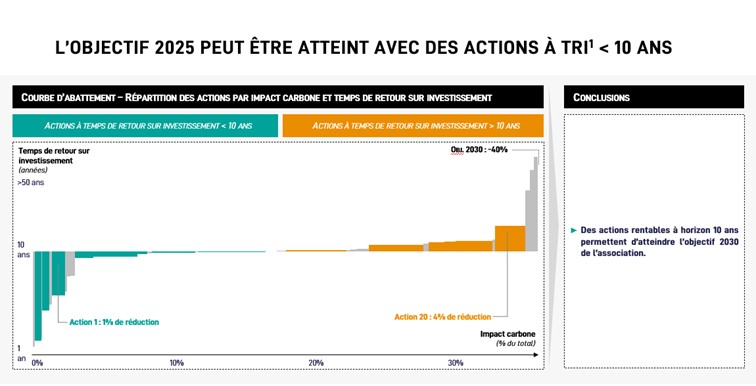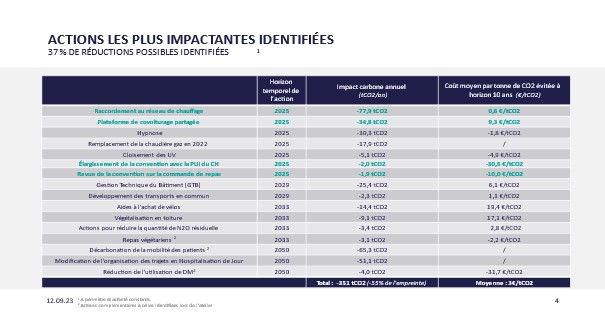Les associations et ONG qu’elles agissent dans le secteur humanitaire, social, sportif, culturel font face à un paradoxe : si elles sont souvent en première ligne face aux effets du changement climatique, elles y contribuent également par leurs émissions de Gaz à Effet de Serre (GES).
Les crises récentes liées à l’énergie et au changement climatique[1] ont fortement impacté les associations et les ONG. Elles subissent une hausse de leurs coûts de fonctionnement, notamment de leurs factures d’électricité (hausse de 45% du prix annuel moyen du MWh d’électricité payé par les industriels en 2022 par rapport à 2021[2]), de gaz, de carburant (hausse en moyenne de 20% des prix de l’essence et de 24% entre janvier 2021 et juin 2022 par rapport à leur moyenne de 2020[3]) ou d’alimentation. L’exemple des Restos du Cœur rappelle également qu’elles peuvent subir un effet ciseau, avec un accroissement simultané de la demande (doublement du nombre de repas gratuits distribués au cours de l’été 2023 dans certaines régions), et des coûts de fonctionnement (doublement des achats de nourriture ou encore d’une augmentation des factures d’énergie). Les associations du secteur humanitaire, par exemple, sont donc confrontées aux défis d’une précarisation croissante.
Les associations et ONG contribuent cependant indirectement à ces changements qui les impactent. Chaque activité exercée par une structure associative a un impact carbone sur l’ensemble des catégories d’émissions (les transports, les achats de biens ou de service, la gestion des déchets ou les immobilisations par exemples).
Ainsi, nous verrons dans cet article pourquoi une stratégie climat est une nécessité et une opportunité pour une association qui souhaite réduire son impact environnemental, et comment la définir pour qu’elle impulse une transition concrète pour l’association, au service de sa mission.
Pourquoi lancer sa stratégie climat en tant qu’association ?
Une obligation légale pour les associations de plus de 500 salariés
Toutes les associations[4] de plus de 500 salariés doivent publier sur le site de l’ADEME- tous les quatre ans- un bilan des émissions de GES ainsi qu’un plan de transition (BEGES). Il s’agit d’une obligation légale[5] pour les personnes morales de droit privé.
L’association devra d’abord définir le périmètre de son Bilan Carbone. Il est recommandé d’inclure dans ce périmètre l’ensemble des sites de l’association dès le premier Bilan, quitte à s’appuyer sur des données estimatives et à réaliser en parallèle des Bilans Carbone de sites pilotes qui permettront de préciser la stratégie climat nationale.

Doc 1. L’objectif d’un Bilan Carbone est d’aboutir à un plan d’action carbone.
Une première étape pour lancer une stratégie climat avec une base chiffrée
La réalisation du Bilan Carbone de l’association est l’opportunité de quantifier l’empreinte carbone de l’association dans son ensemble.
Si cette évaluation est indispensable pour faire apparaître les postes d’émissions principaux, l’objectif est toutefois de pouvoir ventiler cette empreinte à une maille pertinente, selon l’organisation interne : par filière, par région, voir si possible par site et typologie d’activité (par exemple, un village associatif, une collecte de textile, une distribution de denrées alimentaires, etc.).
Cette ventilation permettra d’identifier des actions de décarbonation pertinentes pour chaque type d’activité : un village sportif se concentrera sur le déplacement des visiteurs et sur ses achats, tandis qu’un service à domicile ou de maraude se focalisera sur les émissions liées au transport des salariés et des bénévoles.

Doc 2. Réaliser une « Fiche-site » pour chaque typologie d’activité permet de diffuser les résultats du Bilan Carbone d’un site pilote à d’autres sites n’ayant pas réalisé de Bilan Carbone mais ayant la même activité.
Des actions dont les effets attendus sont plus larges que la seule réduction des émissions de GES
Un plan d’action climat accroît l’attractivité de l’association pour ses parties prenantes en devenir
Sur le plan réputationnel, il s’agit de répondre aux demandes croissantes des parties prenantes de la structure associative en matière de Responsabilité Sociétale des Organisations (RSO) : bénévoles et salariés, donateurs et adhérents.
Par exemple, une stratégie climat est une première réponse à la demande des jeunes générations qui cherchent un sens à leur action : elle permet de montrer qu’au-delà de sa mission initiale, l’association cherche aussi à minimiser son impact, en particulier environnemental. Dans un contexte de recrutement tendu, elle peut contribuer à rendre l’association davantage attractive (par exemple, lorsqu’elle est en compétition avec des acteurs à but lucratif).
De même, en contrepartie de leur implication financière, les donateurs peuvent attendre des engagements climatiques de la part de l’association, tout comme les salariés nouvellement recrutés.
Un plan d’action climat permet d’identifier et de réaliser des actions rentables
La définition d’une stratégie climat peut aider à la réalisation de gains de coûts et des performances financières de l’association. L’objectif de la stratégie climat est en effet d’identifier les actions de décarbonation à prioriser : celles qui sont les plus impactantes et les moins coûteuses, voire les plus rentables. Cette analyse peut par exemple révéler que la réduction du gaspillage alimentaire est une priorité, ou qu’il est préférable d’installer des pompes à chaleur plutôt que d’acheter des véhicules électriques, à montant d’investissement équivalent.

Doc 3. Les mesures dont le coût d’abattement[6], c’est-à-dire le montant en euro(s) dépensé pour chaque tonne de CO2 non émise, est faible ou négatif seront priorisées. Si le coût d’abattement d’une mesure est négatif, cela signifie que sa mise en œuvre permet de réduire les émissions avec un gain économique pour l’association.
L’approche financière est un des éléments qui permet à la stratégie climat de faire adhérer toutes les parties prenantes à la réflexion autour de la durabilité du modèle d’activité dans le cadre d’une démarche cohérente et encadrée.
Comment élaborer une stratégie climat réussie ?
Une démarche durable respectueuse des contraintes du secteur associatif
Les réflexions à mener autour d’un plan de transition doivent s’inscrire dans une démarche de durabilité pour la structure, sans pour autant compromettre la nature de l’activité (postes d’émissions incompressibles, tels que l’achat de biens de première nécessité neufs ou de médicaments pour une structure de santé) et le respect des impératifs impliqués par le secteur (caractère parfois urgent des missions et des délais).
La construction de la stratégie climat doit bien entendu s’adapter à cette réalité plutôt que de l’ignorer. Le premier enjeu est de faciliter le plus possible la collecte de données aux fonctions support en leur listant précisément les données nécessaires au Bilan Carbone, pour qu’elles aient davantage de temps à mettre à contribution pour la construction du plan d’action.
En complément de la collecte de données nationales, il est également recommandé de réaliser des Bilans Carbone de sites pilotes volontaires : ceux-ci permettront d’identifier les profils carbone des différentes typologies de sites de l’association lorsqu’elle gère des missions multiples.
Une collecte de données complète, à une maille adaptée à l’association
La collecte de données est une étape indispensable d’un Bilan Carbone : elle doit être la plus complète possible afin de permettre d’estimer l’empreinte carbone de l’ensemble de l’association, et elle doit s’effectuer à un degré de granularité pertinent qui permettra de ventiler cet impact par type d’activité.
Les données disponibles peuvent être inégalement disponibles entre différents établissements (degrés de précision variable des inventaires entre les sites, voir une absence d’inventaire ou de mise à jour de la base de données du patrimoine, des dépenses variées et inégales sur les postes d’émissions[7]).
Par ailleurs, l’accès aux données peut-être complexe en raison du caractère souvent décentralisé des opérations. C’est la raison pour laquelle il est préconisé de réaliser des bilans carbone de sites pilotes, afin de s’assurer ensuite des estimations réalisées au niveau national pour chaque type d’activité.
A titre d’exemple, si l’association est structurée en filière, il est judicieux de prendre un échantillon de sites pour chaque filière.

Doc. 4. Un Bilan Carbone permet de classer par importance les postes principaux d’un site par poste d’émissions (ici : une structure d’accueil de personnes en situation de handicap, où les repas et les médicaments sont les achats les plus impactants).

Doc. 5. Un atelier avec les salariés et bénévoles du site permet d’identifier une liste d’actions à la fois impactantes et adaptées à sa réalité.

Doc. 6. Une fiche-action cible une mesure impacte pour l’association qui réalise sa stratégie climat.
En résumé, la réalisation d’une stratégie climat pour une structure associative délocalisée
Dans l’ensemble, il est essentiel dans le cadre de la démarche de réalisation d’une stratégie climat ambitieuse et efficace :
- Que la collecte de données et la réalisation du plan d’action carbone s’adaptent aux spécificités de l’association, dont les activités de la structure peuvent être plus ou moins délocalisées et diversifiées ;
- Que la collecte et les calculs d’empreinte carbone s’effectuent aux échelles métiers et territoriales appropriées ;
- Que la stratégie climat soit co-élaborée avec des représentants du terrain ;
Ces éléments garantiront que le plan d’action sera adapté au terrain et réaliste, et impulsera une réduction durable de l’empreinte ainsi qu’idéalement des synergies positives (économies financières, attractivité, etc.) pour la structure associative.
Cette démarche permettra d’enclencher la transition durable de l’association, et d’anticiper dès maintenant les changements qui pourraient nuire à sa mission, comme la hausse du prix de l’énergie et du carbone, donc des dépenses d’achat de l’association.
[1] L’Observatoire européen Copernicus a alerté l’opinion publique de l’enregistrement au cours des trois derniers mois de l’été (juin, juillet, août) 2023, des températures moyennes mondiales les plus hautes jamais mesurées.
[2] Données INSEE, paru le 8 juin 2023. La hausse des prix de l’énergie a été majoritairement répercutés dans les prix de vente par les établissements industriels.
[3] Données INSEE, paru le 19 décembre 2022.
[4] Texte de référence, loi du 1er juillet 1901 relative aux contrats d’association
[5]Article L.229-25 du code de l’environnement ; articles R.229-45 à R.229-50-1 précisant les modalités d’application des obligations.
[6] Le coût d’abattement se calcule en divisant le surcoût total de la mesure (en termes d’investissement financier et humain) par les émissions évitées.
[7] Il s’agit de l’exemple des dépenses en services externalisées qui sont difficiles à relier à un impact carbone précis etc.





